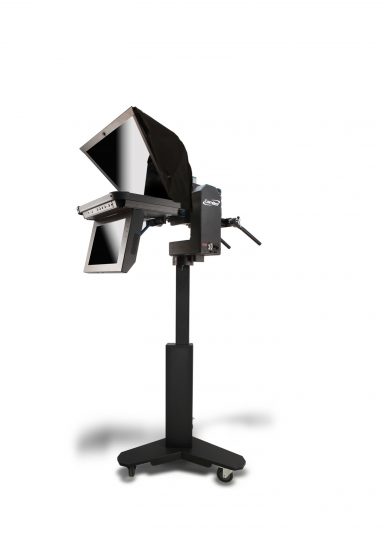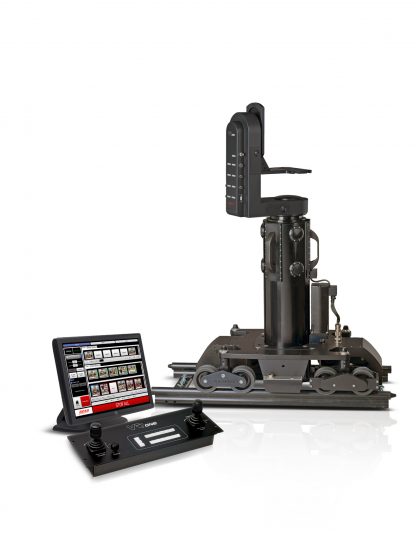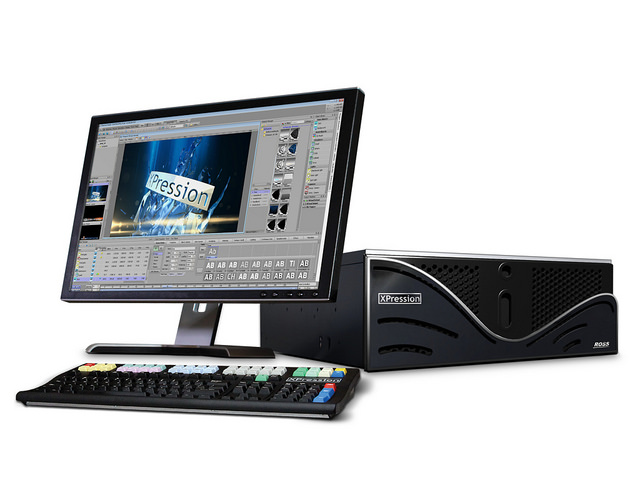NAB 2017: Ross Video Showcases Gear for Virtual and Live Production
Ross Video highlighted a range of robotic cameras, virtual-studio–graphics rendering, and next-generation Xpression graphics.
CamBot Line of Free-Roaming Pedestals
Two additions to the CamBot line of free-roaming pedestals leverage the geometry of the robotic XY base developed for the industry-leading CamBot 700XY. The new 600XY series pedestals offer the same accuracy, repeatability, and reliability as the CamBot 700XY, and both new models feature the mid-range 600PT pan/tilt head, which combines a 57-kg (125-lb.) payload capacity with fast, smooth, and accurate movements. Available in two configurations, users now have a choice of three models in purchasing a CamBot free-roaming pedestal.
The entry-level 600XY-S2 combines a cost-effective two-stage lift with the 600PT head, and the mid-range 600XY-S3 leverages the three-stage lift from the 700XY, providing a 50% increase in elevation range relative to the S2 version. The payload capacity of the 600XY is ideally suited for most studio camera rigs, which typically include an ENG/EFP or box camera and lens, prompter and talent monitor, tally light and clock, and other accessories. The two new models provide a more cost-effective alternative to the heavy-duty 700XY for studios where the payload is a little lighter and the full power of the 700XY is not required.
The price of the 600XY-S2 offers an alternative to customers looking for a studio robotics solution. As the cost of cameras, lenses, and prompters has dropped, many budget-conscious studios have opted for five or six pan/tilt heads on tripods and were forced to sacrifice flexibility and creativity by giving up the floor and elevation movements afforded by fully robotic pedestals while creating congestion in the studio. The total cost of three-camera chains based on 600XY-S2 pedestals will often be less than a comparable setup based on five or six robotic pan/tilt heads on tripods. This means that users can now enjoy the benefits of a free-roaming pedestal while saving money and reducing complexity.
“Customers have been looking for a solution that provides a way for them to get back some of the advantages they enjoyed when they still used manual pedestals, such as the flexibility to reposition cameras anywhere in the studio or the visual appeal of on-air movements,” says Bruce Takasaki, marketing product manager, Ross Robotics. “With the 600XY series, Ross has made that possible by offering a fully featured robotic pedestal at a price point that changes the economics of studio robotics.”
With industry-leading accuracy provided by the differential-steering technology incorporated in CamBot, the 600XY pedestals are also suited for virtual studios and augmented reality. Tracking data is included with all three members of the CamBot free-roaming pedestal series, at no extra charge. This makes CamBot one of the central elements of Virtual Solutions packages from Ross Video. As with all Ross Robotics, the CamBot 600XY series integrates tightly with Ross Overdrive and third-party automated production-control systems.
The CamBot 600XY series pedestals are members of the industry’s broadest portfolio of studio-quality camera robotics, all designed, developed, and manufactured internally.
Furio SE Robotic Camera System
Available today, the next generation of the Furio robotic camera system, the Furio SE, represents the Smart Evolution of the Furio rail-based dolly system. The dolly and lift have been completely redesigned to improve performance, robustness, and reliability, while also making it safer to operate.
It incorporates more than 40 new features, enhancements, or performance improvements, and includes a number of new technologies. The carbon-fiber lift is more than 20% taller than the original lift, and offers 50% greater extension range, without increasing weight or sacrificing rigidity. The lift is also twice as fast as its predecessor, while maximum dolly speed has been increased by 33%, thanks to the new Safe-T-Glide wheel-locking system.
Electronics have been completely redesigned into two field-replaceable units (FRUs) incorporating features that reduce the total number of external connections and protect the ones that remain. In case something does go wrong, the FRU can be replaced in under a minute by simply removing four screws.
Safety features of the Furio SE include front and rear E-stop buttons that instantly cut power to the system in case of an emergency. Remote E-stop modules are also available for placement anywhere in the studio or control room. Front and rear motion light bars produce a gently flashing amber light to warn anyone in the vicinity when the system is in motion. Safe-T-Glide wheels lock the dolly to the track, ensuring that it cannot tip over, even when traveling at high speed and with the lift fully extended.
Adding either a VR100 or VR600 head in a Furio SE Studio system enables the optical axis to extend as high as 2.2 m (7 ft. 3 in.) above the ground, from which it can descend 87 cm (34 in.). This provides an even wider range of camera angles and viewing perspectives, while enabling even more dramatic moving shots. The same dolly and lift will also support the FXhead to form a Furio SE Live system. Both systems are fully compatible with existing rail systems, including the wiredraws, collision-avoidance modules, and control-system hardware, including the Panbar and joystick controls on the Furio SE Live and SmartShell 4 for Furio SE Studio.
In conjunction with the new Furio SE lift and dolly, the new Furio SE Blackbird pedestal is designed for use in situations where robotic floor movement is not required. Like all Ross Robotics systems, Furio SE integrates tightly with Ross Overdrive and third-party automated production-control systems. Furio SE is also a central element of Ross Video Virtual Solutions packages.
Frontier Virtual-Production Solutions
Produced in collaboration with The Future Group, Ross Video’s Frontier is the latest virtual-studio–graphics–rendering platform.
“Frontier is a real game-changer in the virtual-solution market space,” says Gideon Ferber, director of marketing product management, Ross Virtual Solutions. “It will give our customers the tool set to accomplish their wildest creative ideas while maintaining a hyper-realistic look and feel. One of these customers includes TV2 East Denmark, who we are happy to announce as our first Frontier customer in EMEA.”
Frontier offers designers incredible levels of creative freedom combined with hyper-realistic rendering quality that makes virtual sets look much more natural and convincing. Even the most complex graphical elements — from rain drops and fire to live shadows and reflections, lens flares and dynamic highlights — are created quickly, easily, and realistically.
At its core, Frontier is a cutting-edge videogaming engine capable of amazingly photorealistic scenery, and it has been optimized by Ross Video to work in Virtual Studio broadcast environments.
Frontier uses Epic Games’ Unreal gaming engine as the core render engine, which provides exceptional high-realism scenery through state-of-the-art features, such as particle systems, dynamic textures, live reflections, shadows, and even collision detection.
Used for rendering background scenery or foreground objects, Frontier works seamlessly with Ross Video XPression motion-graphics systems to provide workflow tools and data connectivity.
This combination with XPression offers the best of both worlds: photorealistic backgrounds and unparalleled creative freedom, along with unmatched data connectivity, visual-logic programming, and full support for most virtual studio-production workflows.
XPression Graphics Systems Enhanced With IP, SDI I/O
The latest in Matrox-empowered Ross XPression CG and graphics systems demonstrated IP- and 12G SDI-based CG workflows propelled by the next generation of XPression systems and cutting-edge Matrox X.mio3 hardware.
A response to broadcast’s growing demand for 4K, the new XPression 12G CG system integrates the recently launched Matrox X.mio3 12G. Allowing one-cord transport of 4K signals over SDI — crucial in production trucks, where the complexity and weight of cabling are a major concern — the XPression 12G will feed a Ross Ultrix Carbonite UHD switcher, driving CG insertion across the 12G-SDI graphics workflow.
“We are already providing augmented-graphics support and virtual sets to a wide range of networks and programming including NBC Sports’ Sunday Night Football, NASCAR on Fox, Spike TV’s UFC Fight Series, and ABC News,” says Patrick Twomey, director, XPression product management, Ross Video. “Thanks to Matrox, XPression systems are well positioned in the exploding field of 4K workflows.”
For the IP showcase on the show floor, Ross contributed a SMPTE 2110-compliant camera to output over IP to an XPression IP graphics system, also outputting SMPTE 2110. IP-enabled by the MatroxX.mio3 IP interface hardware, the XPression IP system transmits video over high-speed 10GbE network connections, demonstrating the flexibility and reach that can be provided when working with IP.
“These are exciting times in our industry,” says Francessco Scartozzi, director of sales (Americas), Matrox. “I am happy to see that the broadcast industry is standardizing on ST 2110. Our ST-2110 solutions enable our OEM customers, like Ross, to respond to calls for IP workflows from their broadcast customers.”



